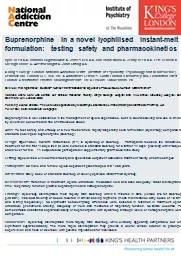

Kylie Reed ab Karolina Bogdanowicz b James Bell ab Rob VanderWaal a Jenny Keen ab Pete Beavan a Shelagh Baillie c Alastair Knight d John ID: 474718
Download Presentation The PPT/PDF document "Buprenorphine in a novel lyophilised ins..." is the property of its rightful owner. Permission is granted to download and print the materials on this web site for personal, non-commercial use only, and to display it on your personal computer provided you do not modify the materials and that you retain all copyright notices contained in the materials. By downloading content from our website, you accept the terms of this agreement.
Slide1
Buprenorphine in a novel lyophilised instant-melt formulation: testing safety and pharmacokinetics
Kylie Reed
a,b, Karolina Bogdanowicz b, James Bell a,b, Rob VanderWaal a, Jenny Keen a,b, Pete Beavan a, Shelagh Baillie c, Alastair Knight d, John Strang a,b a King’s College London, National Addiction Centre (Institute of Psychiatry, Psychology and Neuroscience), Denmark Hill, London SE5 8BB, UK; b Addictions Services, South London & Maudsley NHS Foundation Trust, London; c Martindale Pharma, Buckinghamshire, UK; d Evicom, Twickenham, UK.
Buprenorphine is well established in the management of opioid dependence, but it is slow-dissolving and use is limited by diversion concerns and risk of intravenous abuse. Aims: To test safety and efficacy of a new freeze-dried, rapidly-dispersing solid formulation (Zydis-bup) compared to standard sublingual buprenorphine (Sub-bup). Design: Open-label, two-arm randomised (2:1) to Zydis-bup or Sub-bup. Participants received the randomised treatment for the first 14 days then all were switched to standard Sub-bup for a further 14 days; providing within-subject cross-over for 2/3. 11 subjects also participated in supplementary pharmacokinetic study.Setting: Specialized clinical trials facility and specialized outpatient addictions treatment facility on same campus.Participants: 36 male and female opioid dependent patients aged ≥18 - ≤60 years. Intervention: Daily dose of standard Sub-bup or novel lyophilised instant-melt Zyd-bup.Measurements: Retention in treatment; opiate withdrawal; medication hold and dose adequacy; tablet disintegration time; respiratory function; plasma buprenorphine and norbuprenorphine.Findings: Zydis-bup disintegrated more rapidly than Sub-bup: within 2 minutes in 58% (versus 5% for Sub-bup; p<0.001). Individual tailoring of doses resulted in similar dosing regimens (mean maintenance daily doses of 10.8mg and 9.6mg respectively). No significant between-group differences were detected in retention in treatment, opiate withdrawal phenomena, craving, adequacy of ‘hold’ and measures of respiratory function. No SAEs occurred. PK demonstrated substantial supra-availability of buprenorphine with Zydis-bup although levels of norbuprenorphine were comparable.Conclusions: Zydis-bup disintegrated more rapidly than Sub-bup, while clinically appearing comparable, but with significant supra-availability. The more rapid disintegration may provide a useful clinical solution to prolonged supervision and risks of diversion, with positive implications for individuals.
Clinical trial registration: EudraCT Number: 2012-003560-49; Sponsor's Protocol Code Number: MD2012/01XPAddress where work was carried out: Clinical Research Facility, King’s College Hospital and AAU annex, Maudsley Hospital, both Denmark Hill, London, SE5Funding source and DoI: The work was sponsored by Macarthys Laboratories Limited (trading as Martindale Pharma), UK. Fuller DoI detail at authors’ webpages